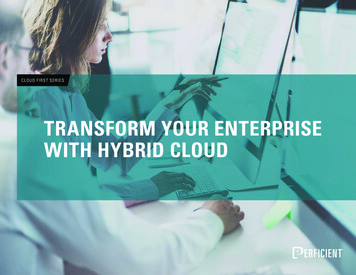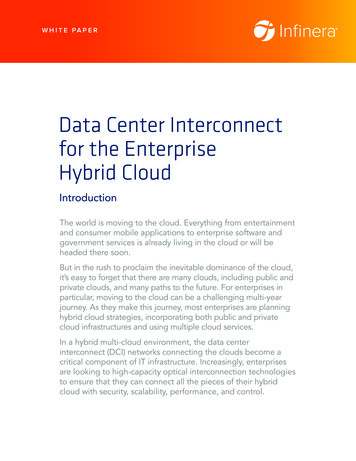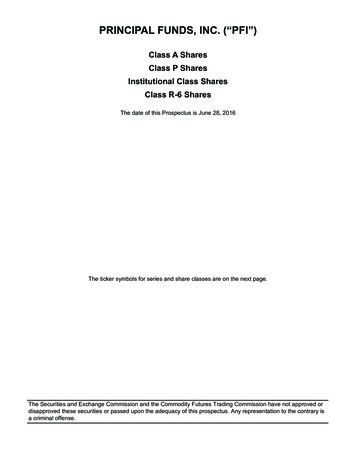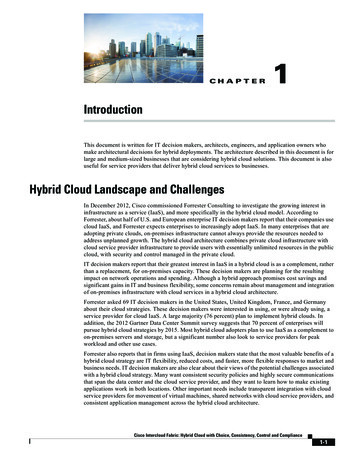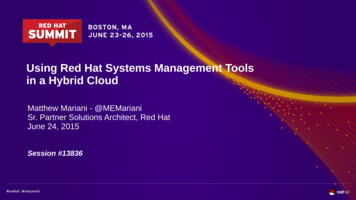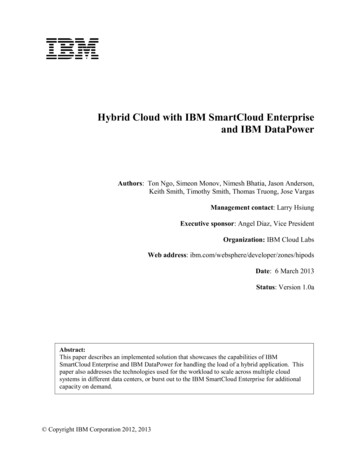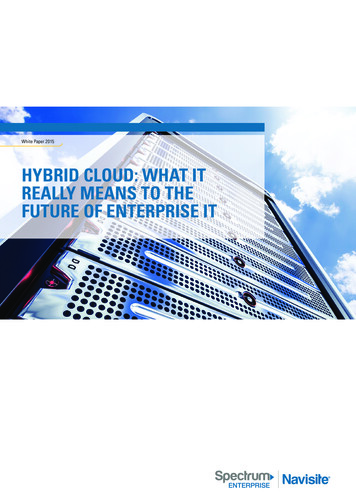
Transcription
White Paper 2015HYBRID CLOUD: WHAT ITREALLY MEANS TO THEFUTURE OF ENTERPRISE IT
White Paper: Hybrid Cloud: What It Really Means to the Future of Enterprise IT2TABLE OF CONTENTSHybrid Cloud and the Messy Realities of IT . . . . . . . . . . . . . . . . . . . . . . . . . . . . . . . . 3What Is Hybrid Cloud? . . . . . . . . . . . . . . . . . . . . . . . . . . . . . . . . . . . . . . . . . . . . . . . . . . 4The Drive to Embrace Hybrid . . . . . . . . . . . . . . . . . . . . . . . . . . . . . . . . . . . . . . . . . . . . . 5Hybrid Cloud Strategies . . . . . . . . . . . . . . . . . . . . . . . . . . . . . . . . . . . . . . . . . . . . . . . . . 6Running Out the Clock on Legacy Investments . . . . . . . . . . . . . . . . . . . . . . . . . . . 6Building on Virtualized Data Centres . . . . . . . . . . . . . . . . . . . . . . . . . . . . . . . . . . . 6Differentiating Application Workloads . . . . . . . . . . . . . . . . . . . . . . . . . . . . . . . . . . 6Addressing Security/Compliance Concerns . . . . . . . . . . . . . . . . . . . . . . . . . . . . . 7Next-Generation Applications . . . . . . . . . . . . . . . . . . . . . . . . . . . . . . . . . . . . . . . . . 7The Management Challenge in Going Hybrid . . . . . . . . . . . . . . . . . . . . . . . . . . . . . . . 8Conclusion . . . . . . . . . . . . . . . . . . . . . . . . . . . . . . . . . . . . . . . . . . . . . . . . . . . . . . . . . . . . 9About Navisite . . . . . . . . . . . . . . . . . . . . . . . . . . . . . . . . . . . . . . . . . . . . . . . . . . . . . . . 10
White Paper: Hybrid Cloud: What It Really Means to the Future of Enterprise IT3HYBRID CLOUD AND THEMESSY REALITIES OF ITTo outsiders, particularly nontechnical ones,the world of IT can seem pretty cut anddried—a yin and yang universe of zeroesand ones.In fact, the daily reality of IT is far messierthan most outsiders could possiblyimagine. Programming is as much an artas a science. Two applications designed toachieve the same goal can work in entirelydifferent ways. A large IT project in thevirtual world can be as complicated asany brick-and-mortar construction projectin the real world. Lots of integrations areheld together by little more than the digitalequivalent of scotch tape and safety pins.Even something as seemingly binary asinformation security—keeping bad guysout, letting good guys in—is a complexundertaking.In its early days, the cloud seemed topromise another ostensibly cut and driedIT fork in the road: Host your technology onpremise or host it in the cloud. But time andtime again, the decision has turned out tobe not quite so simple.While there are some basic givens onany route to the cloud—replace CapExfor OpEx, trade control for scalability—the decision-making matrix is inevitablydifferent for every organisation. Lotsof variables are factored into the cloudequation, such as applications, workloads,skill sets, legacy investments, budgets,market pressures, risk tolerance, securityconcerns, and regulatory considerations.What seems like a black and white decisiontakes on many shades of grey.All of this explains why the phenomenonknown as ‘hybrid cloud’ is more than apassing fad. Hybrid clouds were initiallyviewed as waystations on the road topurer all-cloud implementations. In reality,for many (if not most) organisations,hybrid is really a way to address thefundamental challenge of IT—its messyreality. This is why, for the foreseeablefuture, hybrid cloud implementation islikely to be a permanent state of affairsfor many enterprises. As the researchfirm Forrester has noted, ‘Enterprisesneed to acknowledge this reality and startmanaging their hybrid state now, ratherthan viewing hybrid as some mythicalfuture state.’11 Forrester, “It’s A Hybrid Cloud World: Are You ManagingYour Hybrid State?” September 2014.3
White Paper: Hybrid Cloud: What It Really Means to the Future of Enterprise ITWHAT IS HYBRID CLOUD?4The term ‘hybrid cloud’ is arguably asoverused today as ‘cloud’ itself, andprecise definitions vary. As a baseline,‘hybrid’ refers to an implementation thatincludes a mix of internal (on-premise, oftenvirtualised) and external (cloud-hosted)solutions, with applications switchingbetween resources as needed. Forsimplicity’s sake, the breakdown in private/public cloud options is typically viewed asfollows:There can be many variations on the hybridmodel.On-premise corporate private cloud:The enterprise’s IT department hastraditional applications provisioned withone application per given server (or set ofservers) or virtualised—all within its fourwalls. Combining private cloud serviceswith client-hosted virtualenvironments Combining a self-service ormanaged cloud with a moretraditional managed hostingenvironmentHosted private cloud: The IT departmentopts to physically store its servers andother equipment with a third-party hostingprovider, which manages the equipment andapplies optimised virtualisation techniquesin a single-tenant configuration.Hosted virtual private cloud: A hostingprovider offers standardised, productisedhosting that combines a cloud-enabledinfrastructure, cloud management, andself-service options with specific servicesfor application management, virtualiseddesktops, business continuity and disasterrecovery, and more. Clients benefit fromefficient multitenancy of the infrastructurewhile preserving some resource isolation toensure appropriate levels of cloud service.At its most basic, hybrid can combine apublic cloud service, such as Dropbox, withone or more services running in the onpremise data centre. According to Forrester,that’s now the case in 70 per cent ofenterprises, and once a business has donethat, it’s gone hybrid.2Hybrid can also take the form ofAt Navisite , we frequently find ourclients benefiting from what we call‘hybrid applications’: the client’s physicalinfrastructure integrated with Navisite’sNaviCloud platform to deliver enterpriseclass managed application services.Using this approach, enterprises get thebest of the cloud—rapid deployment,scalable, consumption based billing—whilestill taking advantage of costly legacyinvestments.Public cloud: The enterprise taps intoa public set of resources deliveringstandardised, highly automated offeringswhere compute resources, complementedby storage and networking capabilities, areowned by a service provider and offeredto the client on demand with limitedSLAs regarding tenancy, isolation, andperformance.2 Forrester, “It’s A Hybrid Cloud World: Are You ManagingYour Hybrid State?” September 2014.4
White Paper: Hybrid Cloud: What It Really Means to the Future of Enterprise ITTHE DRIVE TO EMBRACEHYBRIDHowever you define it, the concept ofa mixed implementation of both cloudbased and premise-based capabilitieshas taken off and is likely to constitutethe largest and most used segment of thecloud computing market in coming years.TechNavio, which valued the hybrid cloudmarket at a moderate US 21.18 billion inrevenues in 2013, forecasts a remarkableCAGR of 29.22 per cent through 2019—farfaster than IT growth overall.3While hybrid cloud adoption is being drivenby many of the same factors that drivecloud adoption, such as the ability to rollout new infrastructure or applicationsquickly and the reduction in capital costsand consumption-based billing, hybrid clouddeployment also has its own set of drivingfactors.According to research firm Gartner, theuptake in hybrid deployment has coincidedwith a shift in the use of cloud technologyfrom testing to deployment: ‘Real solutionsrequire a more sophisticated architecturethat supports business needs and whichallows for an application to be run in manydifferent places.’4 In effect, hybrid reflectsthe new realities of how computing is donegenerally—not just of how the cloud isimplemented.3 TechNavio, “Global Hybrid Cloud Market,” available oudmarket-2015-20194 The Wall Street Journal, “CIOs Say Hybrid Cloud TakesOff,” available at ort-cios-say-hybrid-Cloud-takesoff/?mod ST1&ref /news/technology/5Hybrid cloud implementation alsoaddresses things that are missing in pureplay cloud deployments:Licensing: Many commercial applicationsare not licensed to support cloudarchitectures. This makes virtualising theseapplications in a cloud environment costprohibitive.Existing investments: Hybrid cloudimplementation enables an enterprise torun out the clock on its legacy investments.A company that has just completed aserver hardware refresh with an estimated24-month cycle would be hard pressedto move those systems to a cloud-baseddeployment and write off the investment. Ahybrid approach allows greater latitude.Security and compliance: Whileconcerns over security once keptenterprises from shifting their assets tothe cloud, cloud service providers suchas Navisite now offer levels of securitythat many enterprises cannot achieve ontheir own. However, because industry andgovernment regulatory frameworks are stillevolving in this regard, enterprises oftenchoose to adopt a hybrid approach, keepingcertain data on premise to comply withlegal requirements.5
White Paper: Hybrid Cloud: What It Really Means to the Future of Enterprise IT6HYBRID CLOUDSTRATEGIESGiven its compelling advantages, it’simpossible to conceive of a major IT projectgetting off the ground today withoutsome consideration of the role of cloudtechnology. At the same time, roadblocksto cloud adoption, whether self-imposedor driven by regulatory issues, can be justas significant. This has IT organisationsasking, ‘How can I get the best of bothworlds?’—a clarion call that almostinevitably brings such organisations toembrace hybrid cloud.At Navisite, we often see the followingscenarios leading to hybrid cloud:RUNNING OUT THE CLOCK ON LEGACYINVESTMENTSLegacy investments are probably thesingle greatest barrier to cloud adoption. Astrategy of well-thought-out ROI-orientedhybrid cloud investments provides asuccessful way to transition away fromthese already financed infrastructures.BUILDING ON VIRTUALISED DATACENTRESEnterprises that have virtualisedcomponents of their data centres—ineffect creating a corporate cloud—oftensee taking advantage of externally hostedvirtualised services as a logical extensionof this strategy. This is especially true ofenterprises that have tried to implementprivately hosted cloud infrastructuresbut have failed to provision servicesautomatically on the fly. These in-houseprivate clouds become a starting point formore strategic hybrids.DIFFERENTIATING APPLICATIONWORKLOADSA hybrid infrastructure is oftenimplemented by distinguishing betweendifferent applications based on theirspecific functions, seasonal use/scalability, storage requirements, etc.This might involve, for example, keepingsystems focused on customer or partnerengagement (e.g., customer service) inhouse while moving systems that supportrecord keeping and back-end financials tothe cloud. The engagement applicationsmay experience spikes in usage, forexample, during the holiday shoppingseason, which makes the scalability ofcloud-based solutions a major asset, butnot enough to justify moving everything tothe cloud. On the other hand, a businessmight prefer to keep those customer service6
White Paper: Hybrid Cloud: What It Really Means to the Future of Enterprise ITHYBRID CLOUDSTRATEGIES(CONTINUED)systems in house to maximise control overperformance and security while shiftingthe more static applications to the cloud.The permutations are different for everysituation.ADDRESSING SECURITY/COMPLIANCE CONCERNSWhile cloud providers are increasinglyimplementing capabilities that addresssecurity and privacy issues, thoseresponsible for ensuring legal complianceremain cautious. As a result, keepingcertain data sets and applications onpremise is likely to be an ongoing reasonwhy hybrid cloud implementation becomesthe ‘best of both worlds’ compromise,especially in sectors such as health careand financial services.7NEXT-GENERATION APPLICATIONSAs enterprises shift their view of cloudbenefits from lowering CapEx costs tosupporting strategic initiatives, mixedmodels come into play with applicationsbeing run in different places, supportingall kinds of integrations and mashups. Wesee this at Navisite as our clients evolvefrom cloud strategies based largely onearlier hosted or managed business modelsto a mix of managed and self-serviceimplementations. Gartner has suggestedthat this is less about hybrid cloud thanabout multi-cloud environments providingthe foundation for the next wave ofapplications—integrating cloud-basedanalytics with customer data or datacollected by sensors embedded in machinesand other objects.55 The Wall Street Journal, “CIOs Say Hybrid Cloud TakesOff,” available at ort-cios-say-hybrid-Cloud-takesoff/?mod ST1&ref /news/technology/7
White Paper: Hybrid Cloud: What It Really Means to the Future of Enterprise IT8THE MANAGEMENTCHALLENGE IN GOINGHYBRIDFor most big companies, the cloud is oneelement of an increasingly integratedIT infrastructure, one in which bordersdissolve between resources inside andoutside the four walls of the enterpriseand workloads flow in every direction. Thevalue of the cloud remains in the offloadingof resources needed to support a givenapplication or service. Hybrid cloud allowsfor offloading at a much more granularlevel—at specific compute resourcesand applications, but also in managementfunctions. This has created a new demandfor more effective hybrid management.Managing workloads involves a collectionof tedious tasks (patching, monitoring,antivirus, backups) requiring specialisedtools and processes. As enterprises workwith managed cloud providers, picking andchoosing which of those tasks they willcontinue to perform and which they want todelegate to their cloud providers demandsmore granular management options.As no two cloud models are identical, it canbe somewhat challenging to determine thebest management approach for your hybridenvironment. A simple checklist mightinclude things like the following: Does your business implementOS monitoring, applicationmonitoring, backups, AV,patching, authentication,auditing, etc.? Can these features andapplications extend to a publiccloud (architecture, licensing)? What is the degree ofcustomisation and rationale foreach? Are there compliance or legalconsiderations that need to betaken into consideration? Are you looking for self-servicemanagement or a managedservice?This information, coupled with additionalinsight from your technical staff, shouldarm you with the details you need to beginforming a hybrid management model.8
White Paper: Hybrid Cloud: What It Really Means to the Future of Enterprise ITCONCLUSION9The IT world may not be as binary asoutsiders think, but it is unquestionably riskaverse. IT professionals are understandablycautious about when, where, and how theirworkloads are deployed, and a hybrid cloudstrategy fits perfectly into this mind set.The increasingly powerful role the cloudcan play in business transformation ischanging the dynamics of the relationshipbetween service provider and client. Thisputs pressure on both sides to be very clearabout responsibilities.However, hybrid alone is not a panacea.Implementing hybrid cloud may reduce risk,but it isn’t risk free. Foresight, planning, andproactive management are perhaps evenmore critical in a hybrid environment than apure cloud one given the delicate balance ofshared responsibilities between enterpriseand provider.Hybrid is a recognition of the inevitabilityof the cloud and its changing role froma way to control costs to a strategicextension of the business. Being hybrid isnot necessarily the desired end result. Thereal objective is a cloud strategy that fitsyour unique business: a strategy that helpsyou today while ensuring that your IT—wherever it is hosted—is ready for yourneeds tomorrow.9
White Paper: Hybrid Cloud: What It Really Means to the Future of Enterprise ITABOUT NAVISITENavisite, Inc., a part of Spectrum Enterprise,is a leading international provider ofenterprise-class, cloud-enabled hosting,managed applications and services. Navisiteprovides a full suite of reliable and scalablemanaged services, including Application,Cloud Desktop, Cloud Infrastructure andHosting services for organizations lookingto outsource IT infrastructures to helplower their capital and operational costs.Enterprise customers depend on Navisitefor customized solutions, delivered throughan international footprint of state-of-the-artdata centers. For more information aboutNavisite’s services, please visit navisite.comor navisite.co.uk.1010
Navisite Europewww.navisite.co.uk 2016 Charter Communications. All Rights Reserved. Notall products, pricing and services are available in all areas.Pricing and actual speeds may vary. Restrictions may apply.Subject to change without notice. *In accordance withlocal laws, select Microsoft data center locations are notavailable. All other trademarks are the property of theirrespective owners.
White Paper: Hybrid Cloud: What It Really Means to the Future of Enterprise IT 4 4 The term 'hybrid cloud' is arguably as overused today as 'cloud' itself, and precise definitions vary. As a baseline, 'hybrid' refers to an implementation that includes a mix of internal (on-premise, often virtualised) and external (cloud-hosted)


